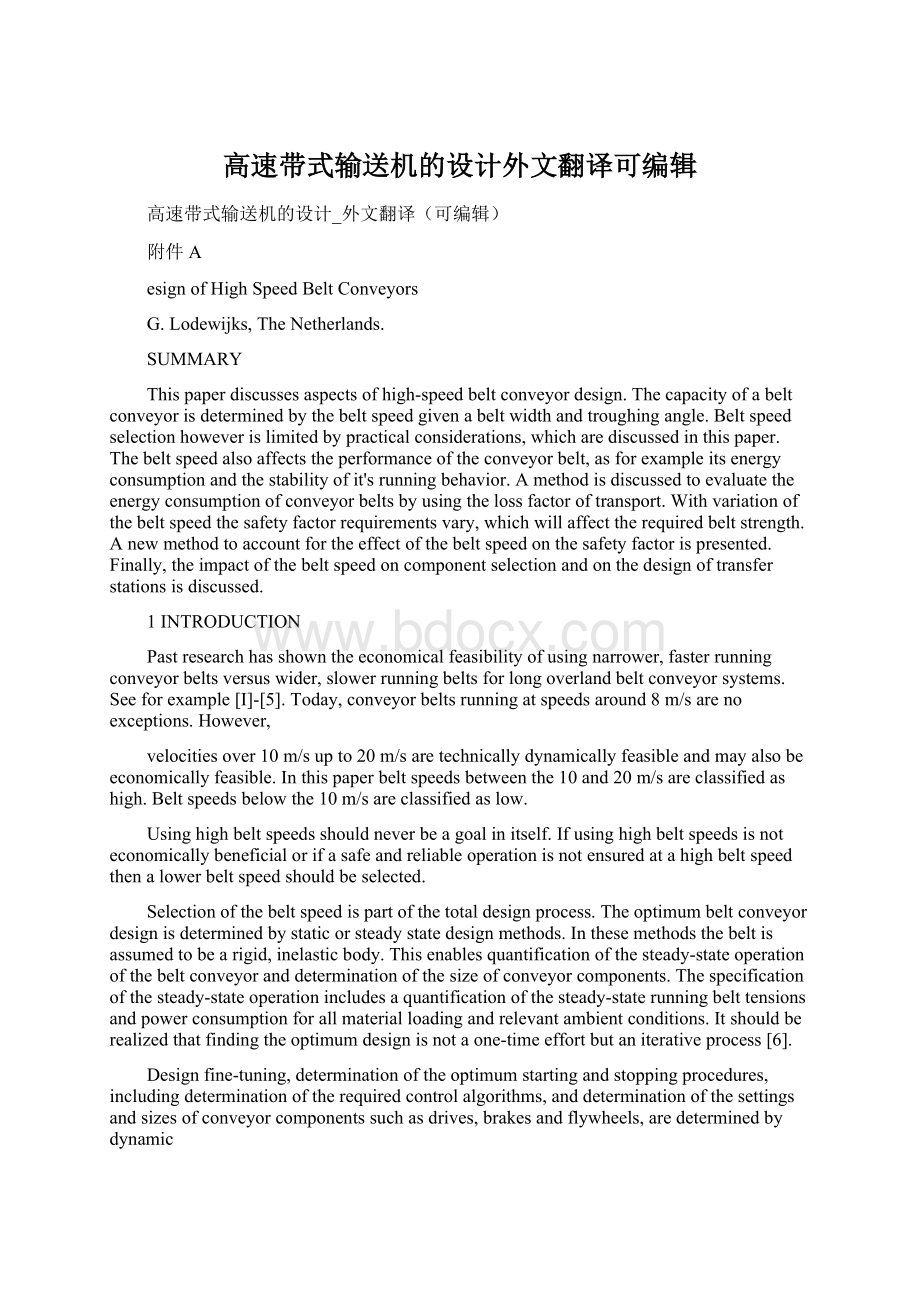高速带式输送机的设计外文翻译可编辑.docx
《高速带式输送机的设计外文翻译可编辑.docx》由会员分享,可在线阅读,更多相关《高速带式输送机的设计外文翻译可编辑.docx(9页珍藏版)》请在冰豆网上搜索。

高速带式输送机的设计外文翻译可编辑
高速带式输送机的设计_外文翻译(可编辑)
附件A
esignofHighSpeedBeltConveyors
G.Lodewijks,TheNetherlands.
SUMMARY
Thispaperdiscussesaspectsofhigh-speedbeltconveyordesign.Thecapacityofabeltconveyorisdeterminedbythebeltspeedgivenabeltwidthandtroughingangle.Beltspeedselectionhoweverislimitedbypracticalconsiderations,whicharediscussedinthispaper.Thebeltspeedalsoaffectstheperformanceoftheconveyorbelt,asforexampleitsenergyconsumptionandthestabilityofit'srunningbehavior.Amethodisdiscussedtoevaluatetheenergyconsumptionofconveyorbeltsbyusingthelossfactoroftransport.Withvariationofthebeltspeedthesafetyfactorrequirementsvary,whichwillaffecttherequiredbeltstrength.Anewmethodtoaccountfortheeffectofthebeltspeedonthesafetyfactorispresented.Finally,theimpactofthebeltspeedoncomponentselectionandonthedesignoftransferstationsisdiscussed.
1INTRODUCTION
Pastresearchhasshowntheeconomicalfeasibilityofusingnarrower,fasterrunningconveyorbeltsversuswider,slowerrunningbeltsforlongoverlandbeltconveyorsystems.Seeforexample[I]-[5].Today,conveyorbeltsrunningatspeedsaround8m/sarenoexceptions.However,
velocitiesover10m/supto20m/saretechnicallydynamicallyfeasibleandmayalsobeeconomicallyfeasible.Inthispaperbeltspeedsbetweenthe10and20m/sareclassifiedashigh.Beltspeedsbelowthe10m/sareclassifiedaslow.
Usinghighbeltspeedsshouldneverbeagoalinitself.Ifusinghighbeltspeedsisnoteconomicallybeneficialorifasafeandreliableoperationisnotensuredatahighbeltspeedthenalowerbeltspeedshouldbeselected.
Selectionofthebeltspeedispartofthetotaldesignprocess.Theoptimumbeltconveyordesignisdeterminedbystaticorsteadystatedesignmethods.Inthesemethodsthebeltisassumedtobearigid,inelasticbody.Thisenablesquantificationofthesteady-stateoperationofthebeltconveyoranddeterminationofthesizeofconveyorcomponents.Thespecificationofthesteady-stateoperationincludesaquantificationofthesteady-staterunningbelttensionsandpowerconsumptionforallmaterialloadingandrelevantambientconditions.Itshouldberealizedthatfindingtheoptimumdesignisnotaone-timeeffortbutaniterativeprocess[6].
Designfine-tuning,determinationoftheoptimumstartingandstoppingprocedures,includingdeterminationoftherequiredcontrolalgorithms,anddeterminationofthesettingsandsizesofconveyorcomponentssuchasdrives,brakesandflywheels,aredeterminedbydynamic
designmethods.Inthesedesignmethods,alsoreferredtoasdynamicanalyses,thebeltisassumedtobeathree-dimensionalvisco-elasticbody.Athreedimensionalwavetheoryshouldbeusedtostudytimedependenttransmissionoflargelocalforceanddisplacementdisturbancesalongthebelt[7].Inthistheorythebeltisdividedintoaseriesoffiniteelements.Thefiniteelementsincorporatevisco-elasticspringsandmasses.Theconstitutivecharacteristicsofthefiniteelementsmustrepresenttherheologicalcharacteristicsofthebelt.Dynamicanalysisproducesthebelttensionandpowerconsumptionduringnon-stationaryoperation,likestartingandstopping,ofthebeltconveyor.
Thispaperdiscussesthedesignofhighbelt-speedconveyors,inparticulartheimpactofusinghighbeltspeedsontheperformanceoftheconveyorbeltintermsofenergyconsumptionandsafetyfactorrequirements.Usinghighbeltspeedsalsorequireshighreliabilityofconveyorcomponentssuchasidlerstoachieveanacceptablecomponentlife.Anotherimportantaspectofhigh-speedbeltconveyordesignisthedesignofefficientfeedinganddischargearrangements.Theseaspectswillbediscussedbriefly.
2BELTSPEED
2.1BELTSPEEDSELECTION
Thelowestoverallbeltconveyorcostoccurintherangeofbeltwidths
of0.6to1.0m[2].Therequiredconveyingcapacitycanbereachedbyselectionofabeltwidthinthisrangeandselectingwhateverbeltspeedisrequiredtoachievetherequiredflowrate.Figure1showsanexampleofcombinationsofbeltspeedandbeltwidthtoachieveSpecificconveyorcapacities.Inthisexampleitisassumedthatthebulkdensityis850kg/m3coalandthatthetroughangleandthesurchargeangleare35'and20'respectively.
Figure1:
Beltwidthversusbeltspeedfordifferentcapacities.
Beltspeedselectionishoweverlimitedbypracticalconsiderations.Afirstaspectisthetroughabilityofthebelt.InFigure1thereisnorelationwiththerequiredbeltstrengthrating,whichpartlydependsontheconveyorlengthandelevation.Thecombinationofbeltwidthandstrengthmustbechosensuchthatgoodtroughabilityofthebeltisensured.Ifthetroughabilityisnotsufficientthenthebeltwillnottrackproperly.Thiswillresultinunstablerunningbehaviorofthebelt,inparticularathighbeltspeeds,whichisnotacceptable.Normally,beltmanufacturersexpectasufficientlystraightrunifapproximately40%ofthebeltwidthwhenrunningempty,makescontactwiththecarryingidlers.Approximately10%shouldmaketangentialcontactwiththecenteridlerroll.
Asecondaspectisthespeedoftheairrelativetothespeedofthebulksolidmaterialonthebeltrelativeairspeed.Iftherelative
airspeedexceedscertainlimitsthendustwilldevelop.Thisisinparticularapotentialprobleminmineshaftswhereadownwardairflowismaintainedforventilationpurposes.Thelimitinrelativeairspeeddependsonambientconditionsandbulkmaterialcharacteristics.
Athirdaspectisthenoisegeneratedbythebeltconveyorsystem.Noiselevelsgenerallyincreasewithincreasingbeltspeed.Inresidentialareasnoiselevelsarerestrictedtoforexample65dB.Althoughnoiselevelsaregreatlyaffectedbythedesignoftheconveyorsupportstructureandconveyorcovers,thismaybealimitingfactorinselectingthebeltspeed.
2.2BELTSPEEDVARIATION
Theenergyconsumptionofbeltconveyorsystemsvarieswithvariationofthebeltspeed,aswillbeshowninSection3.Thebeltvelocitycanbeadjustedwithbulkmaterialflowsuppliedattheloadingpointtosaveenergy.Ifthebeltisoperatingatfulltonnagethenitshouldrunatthehighdesignbeltspeed.Thebeltspeedcanbeadjusteddecreasedtotheactualmaterialvolumeflowsuppliedattheloadingpoint.Thiswillmaintainaconstantfillingofthebelttroughandaconstantbulkmaterialloadonthebelt.Aconstantfillingofthebelttroughyieldsanoptimumloading-ratio,andlowerenergyconsumptionperunitofconveyedmaterialmaybeexpected.Thereductioninenergyconsumptionwillbeatleast10%forsystemswherethebeltspeedisvariedcompared
tosystemswherethebeltspeediskeptconstant[8].
Varyingthebeltspeedwithsuppliedbulkmaterialflowhasthefollowingadvantages:
Lessbeltwearattheloadingareas
Lowernoiseemission
Improvedoperatingbehaviorasaresultofbetterbeltalignmentandtheavoidanceofbeltliftinginconcavecurvebyreducingbelttensions
Drawbacksinclude:
Investmentcostforcontrollabilityofthedriveandbrakesystems
Variationofdischargeparabolawithbeltspeedvariation
Controlsystemrequiredforcontrollingindividualconveyorsinaconveyorsystem
Constanthighbeltpre-tension
Constanthighbulkmaterialloadontheidlerrolls
Ananalysisshouldbemadeoftheexpectedenergysavingstodeterminewhetheritisworththeeffortofinstallingamoreexpensive,morecomplexconveyorsystem.
3ENERGYCONSUMPTION
Clientsmayrequestaspecificationoftheenergyconsumptionofaconveyorsystem,forexamplequantifiedintermsofimumkW-hr/ton/km,totransportthebulksolidmaterialatthedesignspecificationsovertheprojectedroute.Forlongoverlandsystems,theenergyconsumption
ismainlydeterminedbytheworkdonetoovercometheindentationrollingresistance[9].Thisistheresistancethatthebeltexperiencesduetothevisco-elastictimedelayedresponseoftherubberbeltcovertotheindentationoftheidlerroll.Forin-plantbeltconveyors,workdonetoovercomesideresistancesthatoccurmainlyintheloadingareaalsoaffectstheenergyconsumption.Sideresistancesincludetheresistanceduetofrictiononthesidewallsofthechuteandresistancethatoccursduetoaccelerationofthematerialattheloadingpoint.
Therequireddrivepowerofabeltconveyorisdeterminedbythesumofthetotalfrictionalresistancesandthetotalmateriallift.Thefrictionalresistancesincludehysteresislosses,whichcanbeconsideredasviscousvelocitydependentfrictioncomponents.Itdoesnotsufficetolookjustattheimumrequireddrivepowertoevaluatewhetherornottheenergyconsumptionofaconveyorsystemisreasonable.Thebestmethodtocomparetheenergyconsumptionofdifferenttransportsystemsistocomparetheirtransportefficiencies.
3.1TRANSPORTEFFICIENCY
Thereareanumberofmethodstocomparetransportefficiencies.ThefirstandmostwidelyappliedmethodistocompareequivalentfrictionfactorssuchastheDINffactor.Anadvantageofusinganequivalentfrictionfactoristhatitcanalsobedeterminedforanemptybelt.Adrawbackofusinganequivalentfrictionfactoristhatitisnota'pure'
efficiencynumber.Ittakesintoaccountthemassofthebelt,reducedmassoftherollersandthemassofthetransportedmaterial.Inapureefficiencynumber,onlythemassofthetransportedmaterialistakenintoaccount.
Thesecondmethodistocomparetransportationcost,eitherinkW-hr/ton/kmorin$/ton/km.Theadvantageofusingthetransportationcostisthatthisnumberiswidelyusedformanage